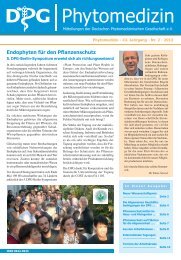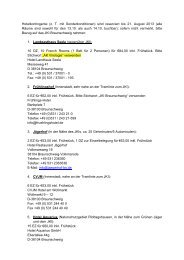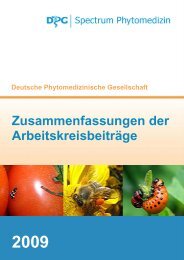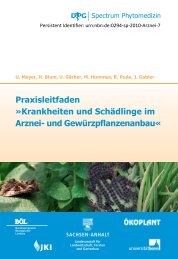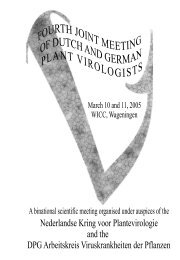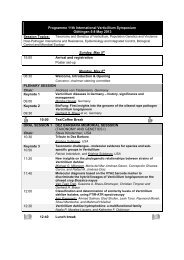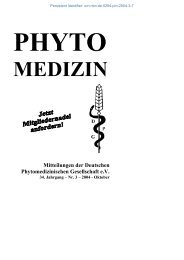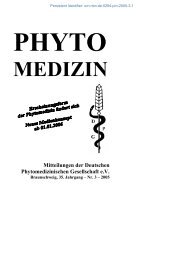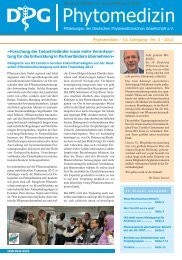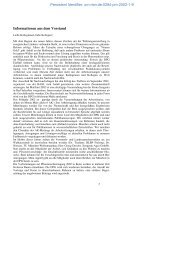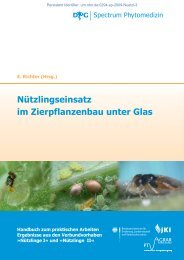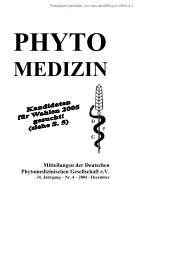Zusammenfassungen der Arbeitskreisbeiträge - Die DPG
Zusammenfassungen der Arbeitskreisbeiträge - Die DPG
Zusammenfassungen der Arbeitskreisbeiträge - Die DPG
Erfolgreiche ePaper selbst erstellen
Machen Sie aus Ihren PDF Publikationen ein blätterbares Flipbook mit unserer einzigartigen Google optimierten e-Paper Software.
Observations, field trials and analysis of a special population<br />
of mayweed (Matricaria recutita) with resistance against<br />
ALS-inhibitors in Schleswig-Holstein (Germany)<br />
C. Schleich-Saidfar 1, H.G. Drobny 2, J. Perez 2, M. Feierler,<br />
F.G. Felsenstein 3, J.-R. Gertz 1 & N. Balgheim 4<br />
1 Landwirtschaftskammer Schleswig-Holstein,<br />
Am Kamp 15–17, 24768 Rendsburg;<br />
2 Du Pont Deutschland, Neu Isenburg;<br />
3 Epilogic GmbH, Freising;<br />
4 Universität Hohenheim, Institut für Phytomedizin<br />
On a cereal field (winter wheat) near Husum (Schleswig-Holstein,<br />
Northern Germany) the control of mayweed by sulfonylureas<br />
became insufficient in 2005. For that reason field trials<br />
were installed from 2006 – 2010 at this place. The trials<br />
showed that the mayweed plants at this site could not be controlled<br />
any longer by sulfonylureas. These herbicides – several<br />
different sulfonylureas were tested – had no more effect at all<br />
on this mayweed, all of them. Seed samples of mayweed from<br />
these trials in 2006 were characterised in different bio-tests.<br />
Dose response curves were obtained with ALS-inhibitors,<br />
done by Epilogic GmbH, at Freising, Germany, initiated by Dr.<br />
H. G. Drobny, Du Pont. The results suggested a specific target-site<br />
resistance against ALS-inhibitors. Further analysis,<br />
done by N. Balgheim, of tissue samples in 2007 with respective<br />
molecular primers confirmed a known mutation at the<br />
ALS. This was the first confirmed case of an ALS-target-site<br />
resistance in mayweed in Germany. The mayweed from the<br />
test-site was resistant especially against sulfonylureas, but not<br />
against triazolo-pyrimidins. The trials showed that the mayweed<br />
from the test site could still be controlled by pyrazolo-pyrimidins<br />
(Florasulam – Primus). At this field sufonylureas<br />
had been used for many years in or<strong>der</strong> to control mayweed,<br />
so an extreme selection pressure had taken place.<br />
Management strategies were <strong>der</strong>ived from the field trials:<br />
The control of mayweed should be done best by the use of<br />
pre-emergence herbicides respectively by these herbicides,<br />
placed just after the emergence of the weed (flufenacet +<br />
diflufenican – Herold or flufenacet + flutamone + diflufenican<br />
– Bacara Forte or – on undrained sites – with IPU-,<br />
CTU-herbicides + diflufenican). In cereals, sown late in autumn,<br />
the control of resistant mayweed should be done by<br />
the application of IPU or CTU (+ diflufenican) in early spring<br />
(March). In Germany the use of CTU is allowed on undrained<br />
fields only. Mayweed remaining from the autumn or mayweed<br />
coming up in spring can also be controlled in spring<br />
(April) by herbicides, containing florasulam (Primus, Starane<br />
XL. Ariane C) or by herbicides containing bentazon (Basagran<br />
DP) respectively by herbicides containing clopyralid<br />
(Ariane C, Duanti) at this site. However, the possibility of<br />
cross resistance against florasulam cannot be quite excluded,<br />
when using it too often. Crop rotation implying the application<br />
of herbicides with different modes of action should be<br />
practiced at any case.<br />
Herbicide resistance in Alopecurus myosuroides and<br />
Apera spica-venti<br />
Dirk Wolber<br />
Landwirtschaftskammer Nie<strong>der</strong>sachsen, Pflanzenschutzamt<br />
Hannover<br />
In Lower Saxony biotests for herbicide resistance with the main<br />
grass weeds Alopecurus myosuroides and Apera spica-venti are<br />
done in greenhouse trials. Samples are taken from regional<br />
plant protection services and sent to the lab in Hannover.<br />
Results from recent years showed that resistance to both grasses<br />
is widespread. Multiple resistance in Alopecurus myosuroides to<br />
J.Plant Dis.Protect. 2/2011<br />
�<br />
: 87<br />
ureas, ACCase, and ALS-inhibitors is quite common. Control<br />
of these biotypes is very hard for the cereal farmers.<br />
Actual status of occurrence of herbicide resistant grass<br />
weeds in Germany<br />
Jan Petersen 1 & Hans Raffel 2<br />
1 University of Applied Sciences Bingen,<br />
2 Syngenta Agro Maintal<br />
Occurrence of herbicide resistance in grass weeds in Germany<br />
is not a new phenomenon, however in recent years spread of<br />
resistance and characters of resistance increased significantly.<br />
In a resistance monitoring program of Syngenta and the<br />
University of Applied Sciences Bingen seed samples of different<br />
winter cereal fields in Germany were tested for resistance<br />
to different leaf active herbicides. Alopecurus myosuroides<br />
(ALOMY), Apera spica-venti (APESV), Lolium sp. (LOLSS) and<br />
Avena fatua (AVEFA) were grown in a greenhouse and sprayed<br />
in the 1 to 2-leaf stage with relevant herbicides.<br />
77% of suspicious ALOMY samples (n = 135) showed a<br />
resistance to cereal selective ACCase-inhibitors. But only 17%<br />
out of these samples showed a cycloxydim resistance (indicating<br />
an ACCase target-site-resistance). Resistance to mesosulfuron<br />
occurs, but also on a lower level (18%). One sample<br />
presented a combination of ALS- and ACCase-target-site resistance<br />
in the ALOMY population. Most of the samples indicated<br />
a cross-resistance or a multiple resistance on the basis of a<br />
non-target-site resistance.<br />
The monitoring on APESV (n = 213) was based on a mixture<br />
of random and sampling on fields with resistance suspicion<br />
(n = 213). Consequently, less biotypes showed a strong<br />
herbicide resistance (29%). Mainly resistance was obvious to<br />
sulfonylureas. 50% of the samples showed a reduced efficacy<br />
and 22% a strong resistance to ALS-inhibitors. IPU-resistance<br />
was detected in 15% of the sites. However, in 61% of the biotypes<br />
a reduced efficacy to IPU was observed. Resistance to<br />
pinoxaden was found in 4% of the samples. In cases of pinoxaden<br />
resistance all biotypes showed a multiple resistance<br />
to sulfonylureas and in some cases also to IPU. Only a few biotypes<br />
(12%, based on 162 samples) expressed a resistance to<br />
pyroxsulam with a cross-resistance to sulfonylureas. In these<br />
cases often an ALS target-site resistance could be detected.<br />
One APESV population showed a combination of an ACCase<br />
and ALS-target-site mutation.<br />
Some samples of AVEFA (n = 6) with control problems in<br />
the fields were tested in the greenhouse with treatments of<br />
ALS-inhibitors and with pinoxaden. No resistance was detected.<br />
For LOLSS 4 samples were analysed. Three out of five samples<br />
showed a resistance to pinoxaden. One sample showed a multiple-resistance<br />
to flufenacet and another biotype showed a<br />
multiple resistance also to ALS-inhibititors.<br />
Glyphosate hormesis – an herbicide shows depth effects<br />
Regina G. Belz<br />
University of Hohenheim, Department of Agroecology (380b),<br />
70593 Stuttgart, regina.belz@uni-hohenheim.de<br />
Glyphosate is currently the most important active ingredient for<br />
controlling weeds. However, glyphosate shows useful effects in<br />
addition to killing weeds at high doses. The patenting of<br />
glyphosate as an herbicide in 1970 was followed by several applications<br />
in the non-lethal, low dose range such as in 1974 a<br />
patent for plant growth-regulation by sub-lethal glyphosate<br />
doses. In the hormetic dose range, where glyphosate has a<br />
stimulating effect on plants, the usage of glyphosate to increase<br />
the carbohydrate content of plants was patented in



